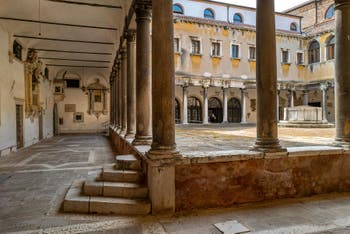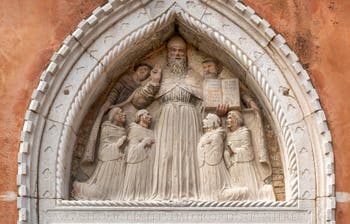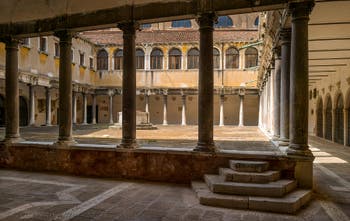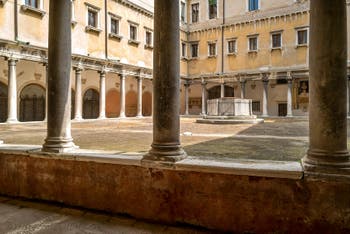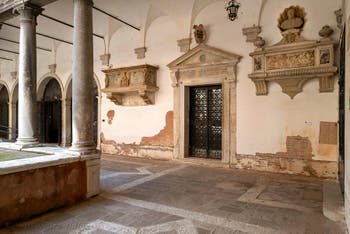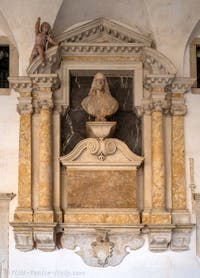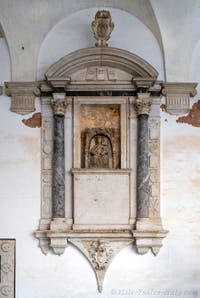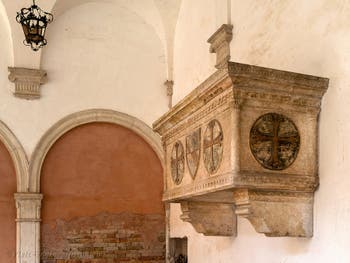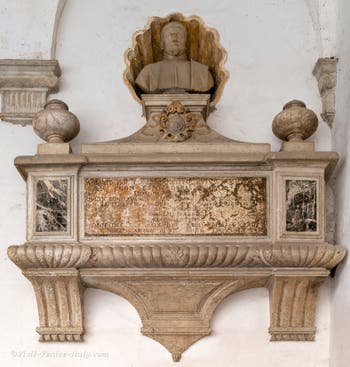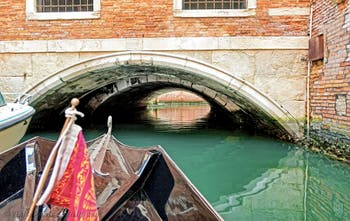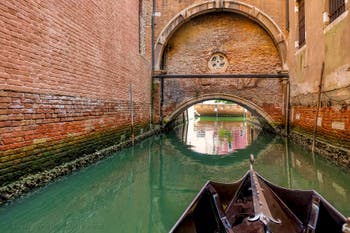Churches Saint-Mark | Miracoli | Stefano | Zaccaria | Murano | Chorus | Mass Hours
Santo Stefano Church and Cloister in Venice
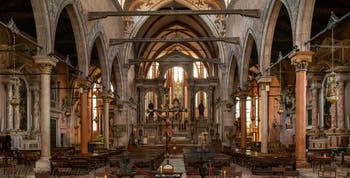
Santo Stefano Church The Santo Stefano Church is one of the last great expressions of flowered Gothic and can also be considered one of Venice's major and beautiful sacred architectures.
It is also the last of the three most prominent churches in Venice to have belonged to a beggar order, St. Augustine.
The church of Santo Stefano's building got started in 1294 by hermits of the order of St. Augustine and brought to an end in 1325.
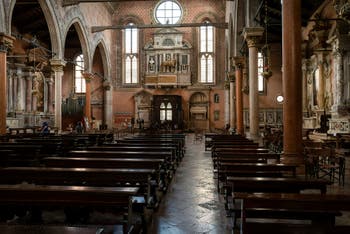
Santo Stefano Church It was then completely rebuilt in the 14th century before undergoing further modifications during the first half of the 15th century.
One carried out significant transformations inside the Santo Stefano church in the 17th century.
According to end travellers of the 19th century, the church of Santo Stefano was in poor condition before its last restoration got carried out between 1900 and 1904.
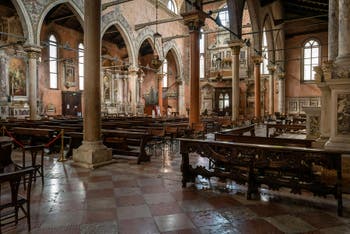
Santo Stefano Church San Stefano is in the shape of a conventual Latin cross.
Still, the interior has bays much narrower than those observed in Franciscan or even Dominican churches.
It has a magnificent gate in Gothic style, made from 1438 to 1442 and attributed to the Venetian sculptor Bartolomeo Bon.
The church had to be consecrated six times because of the attacks perpetrated there.
A Wood Ship's Hull
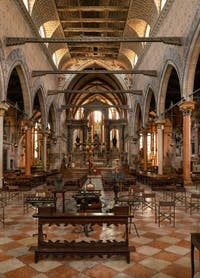
Santo Stefano Church Santo Stefano's central nave has the shape of a ship's hull.
Three naves, including the central nave, built entirely of wood, similar to an upturned boat hull, make up Santo Stefano's church.
Let us not forget the maritime past of Venice and how easy it was for the carpenters of the Venetian Arsenal to make this type of structure in the form of a boat.
That building such a wooden superstructure meant a considerable weight reduction of the complex.
Weight reduction is a vital element because the foundations of the church of Santo Stefano, like those of all other buildings in Venice, are only composed of wooden piles driven directly into the Venetian lagoon.
This big turned-over ship hull that constitutes the nave of Santo Stefano is supported only by thin columns of red and white marble, red brocatelle marble from Verona, and Greek marble, which are sufficient to bear the weight of this lightened nave.
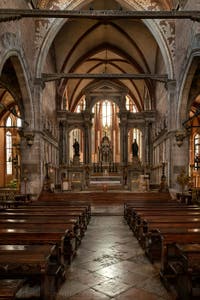
Santo Stefano Church This architectural choice gives a mainly aerial aspect to the church's general structure.
Santo Stefano church, thanks to this architectural option, is of rare elegance.
Slender, compared to other churches in Venice, such as that of the Frari or that of the Santi Giovanni e Paolo, their builders have had to resort to heavy cylindrical stone barrels to hold more classic weighty vaults.
In addition to its golden capitals, the very harmonious opposition of the two red and white tones, presented alternately from one column to another, gives the church a lot of warmth and abundant lighting by its numerous windows.
On the inner walls of the Santo Stefano church, we find the same diamond decoration motif already present on the Doge's Palace, a motif totally of oriental inspiration.
This type of diamond drawing initially of bricks was both in eastern Turkey and Iran.
A Rio goes under the church choir!
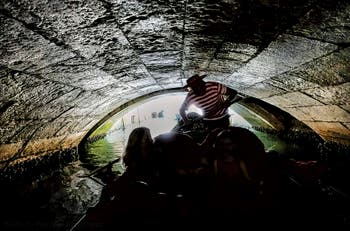
Under Santo Stefano Church Choir Taking advantage of low tide, you can visit under the heart of the church of Santo Stefano by gondola.
We strongly recommend it because awe-inspiring!
The Rio del Santissimo goes straight under the church, starting from the Rio de San Anzolo to the Campo of the same name, to lead to the Grand Canal.
A unique feature in Venice!
Santo Stefano where Doge Francesco Morosini rests
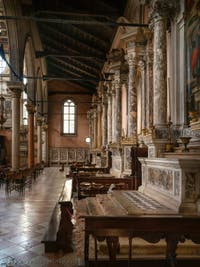
Santo Stefano Church Famous admiral Morosini got buried in the church of Santo Stefano.
Francesco Morosini the Peloponnesian, Captain-General Da Mar, winner of the Turks in the many battles and sieges fought in Greece and Crete in Candia, Nafplio, Lepanto, Coron, Modon, Patras, Corinth, Argos, Navarin, and the list goes on.
A true hero in the eyes of the Venetians, he had no trouble being elected Doge of Venice on April 3, 1688, after the death of Marcantonio Guistinian.
He remained a doge until January 6, 1694, when he died in Nafplion during the new war against the Turks in 1693.
Another son of Venice, or more precisely of Burano, was entitled to a funeral in the church of Santo Stefano: Baldassare Galuppi, a famous Venetian musician who died in Venice on January 3, 1785.

Santo Stefano Church During his funeral, the famous castrate Gasparo Pacchiarotti came to sing to honour Galuppi's memory.
According to the writings of the time, his burial was in San Vitale's church, but nobody has ever found it.
Henry James: Santo Stefano Sepulchral chambers
“But the perfect little sepulchral chambers of the Pancratii, disinterred beneath the church, tell their own tale in their hardly dimmed frescoes, their beautiful sculptured coffin and great sepulchral slab.
Better still the tomb of the Valerii adjoining it, a single chamber with an arched roof, covered with stucco mouldings perfectly intact, exquisite figures and arabesques as sharp and delicate as if the plasterer's scaffold had just been taken from under them.”
Henry James - Italian Hours (1909)
The Cloister Monastery of Santo Stefano in Venice
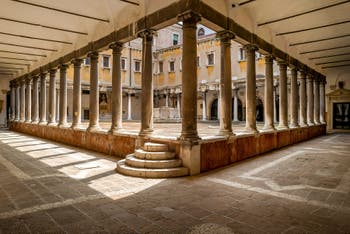
Cloister of Santo Stefano From 1264 to 1274, the hermits of the Order of St. Augustine bought a few houses in the parish of San Angelo to build a monastery and a church that they wished to dedicate to Santo Stefano, the first Christian martyr.
They laid the foundation stone of the construction in 1294 and completed the church of Santo Stefano in 1325.
Doge Andrea Contarini rests in Santo Stefano Cloister
One of the peculiarities of this monastery is the presence of the coffin of the famous Doge Andrea Contarini, who died on 6 June 1382, got buried in the monastery of San Stefano.
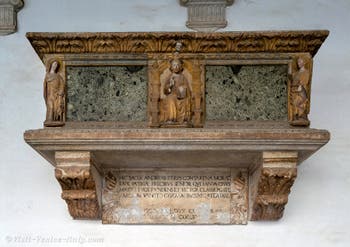
Sarcophagus Doge Andrea Contarini Contarini's sarcophagus is quite simple and located in an unusual place, showing a form of humility that few other doges had, preferring to be buried in more prestigious areas and with generally grandiloquent burials.
Yet Andrea Contarini was an almost hero since he knew how to face Genoa in the most dangerous phase of the history of the Republic when this Venice's rival had taken the island of Chioggia nearby.
The unity of the Venetians in the face of the Genoese aggressors allowed the Serenissima to win this war.
Andrea Contarini's sarcophagus cleaned a few years ago of the dirt that covered it, revealed polychrome gilding and paints.
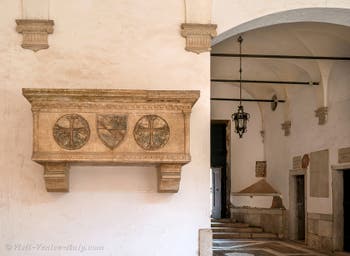
Sarcophagus of Giovanni Soranzo His face and hands carved on the sarcophagus were perfectly preserved.
Francesco Novello by Carrara and Giovanni Soranzo
Another famous person, Francesco Novello de Carrara, the last lord of Padua, got buried in this abbey.He was first an ally of the Republic before deciding to become its enemy, which he paid with his life and two other of his sons, Jacopo and Francesco III.
On 17 January 1405, they got strangled in their prison.
There is also, suspended from the wall, the coffin of Giovanni Soranzo (1378).
The sculptor Tullio Lombardo was also buried there at his request.
Pordenone Frescoes and Titian's Death Threat
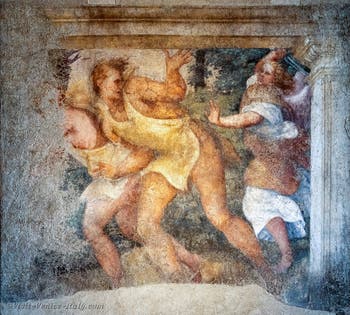
Pordenone, Chased out of Terrestrial Paradise Giovanni Antonio Sacchi, known as Pordenone, decorated the cloister with frescoes.
Some of these frescoes have been restored and visible in Venice's Ca' d'Oro Palace Museum.
Pordenone's frescoes depicted scenes from the Old and New Testaments, like the one showing Adam and Eve driven out of Paradise.
Somebody said that Titian, Pordenone's very aggressive rival, would have threatened his life when realizing these frescoes.
So, Pordenone would have executed the frescoes “the sword to the side and a shield at hand”. Charming, isn't it?
William Howells resumed this story in Venetian life.
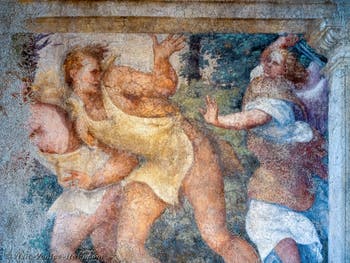
Pordenone, Chased out of Terrestrial Paradise
“Every day we used to pass through the court of the old Augustinian convent adjoining the church of San Stefano.
It is a long time since the monks were driven out of their snug hold; and the convent is now the head-quarters of the Austrian engineer corps, and the colonnade surrounding the court is become a public thoroughfare.
On one wall of this court are remains, very shadowy remains indeed, of frescos painted by Pordenone at the period of his fiercest rivalry with Titian; and it is said that Pordenone, while he wrought upon the scenes of scriptural story here represented, wore his sword and buckler, in readiness to repel an attack which he feared from his competitor.
The story is very vague, and I hunted it down in divers authorities only to find it grow more and more intangible and uncertain.
Cloister of Santo Stefano But it gave a singular relish to our daily walk through the old cloister, and I added, for my own pleasure (and chiefly out of my own fancy, I am afraid, for I can nowhere localize the fable on which I built), that the rivalry between the painters was partly a love-jealousy, and that the disputed object of their passion was that fair Violante, daughter of the elder Palma, who is to be seen in so many pictures painted by her father, and by her lover, Titian.
No doubt there are readers will care less for this idleness of mine than for the fact that the hard-headed German monk, Martin Luther, once said mass in the adjoining church of San Stefano, and lodged in the convent.”
William Howells Venetian Life (1867)
The abbey became at a time as a workshop for Antonio Canova, who carved his “Orpheus” in soft stone.
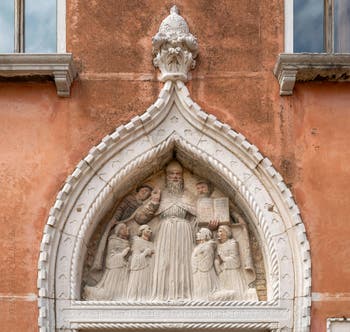
Tabernacle lunette Saint Augustine You can enter this cloister from the left side of the bridge dei Frati, which overlooks the Campo San Anzolo.
There you can admire a magnificent tabernacle bezel on which is a sculpture of Saint Augustine, surrounded by his monks.
This sculpture is interesting in that it has retained much of its original polychrome paintings.
This 15th century Padua work is attributed to Bartolomeo Bellano.
The Italian Tax Department now occupies the abbey, but you can enter it without a problem if you know how to discreetly.
The opening hours are those of the tax department:
Monday: 8:45a.m. to 12:45p.m., closed in the afternoon
Tuesday: from 8:45 to 12:45 in the morning and from 2:45 to 4:45 p.m.
Wednesday: 8:45 a.m. to 12:45 p.m., closed in the afternoon
Thursday: from 8:45 to 12:45 in the morning and from 2:45 to 4:45 p.m.
Friday: 8:45a.m. to 12:45p.m., closed in the afternoon
Closed on Saturday and Sunday
Churches Saint-Mark | Miracoli | Stefano | Zaccaria | Murano | Chorus | Mass Hours
Back to Top of Page


